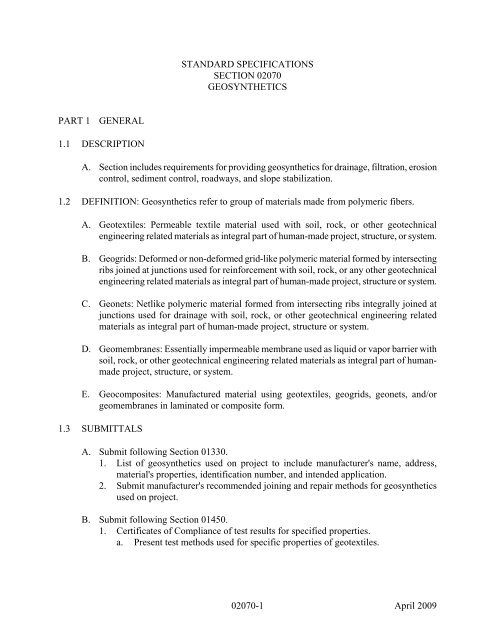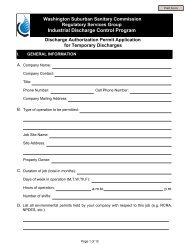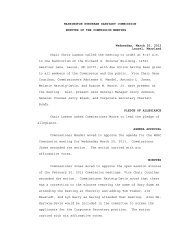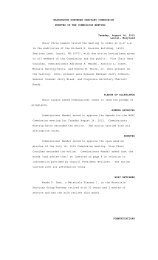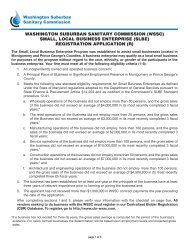02070 Geosynthetics
02070 Geosynthetics
02070 Geosynthetics
Create successful ePaper yourself
Turn your PDF publications into a flip-book with our unique Google optimized e-Paper software.
STANDARD SPECIFICATIONSSECTION <strong>02070</strong>GEOSYNTHETICSPART 1 GENERAL1.1 DESCRIPTIONA. Section includes requirements for providing geosynthetics for drainage, filtration, erosioncontrol, sediment control, roadways, and slope stabilization.1.2 DEFINITION: <strong>Geosynthetics</strong> refer to group of materials made from polymeric fibers.A. Geotextiles: Permeable textile material used with soil, rock, or other geotechnicalengineering related materials as integral part of human-made project, structure, or system.B. Geogrids: Deformed or non-deformed grid-like polymeric material formed by intersectingribs joined at junctions used for reinforcement with soil, rock, or any other geotechnicalengineering related materials as integral part of human-made project, structure or system.C. Geonets: Netlike polymeric material formed from intersecting ribs integrally joined atjunctions used for drainage with soil, rock, or other geotechnical engineering relatedmaterials as integral part of human-made project, structure or system.D. Geomembranes: Essentially impermeable membrane used as liquid or vapor barrier withsoil, rock, or other geotechnical engineering related materials as integral part of humanmadeproject, structure, or system.E. Geocomposites: Manufactured material using geotextiles, geogrids, geonets, and/orgeomembranes in laminated or composite form.1.3 SUBMITTALSA. Submit following Section 01330.1. List of geosynthetics used on project to include manufacturer's name, address,material's properties, identification number, and intended application.2. Submit manufacturer's recommended joining and repair methods for geosyntheticsused on project.B. Submit following Section 01450.1. Certificates of Compliance of test results for specified properties.a. Present test methods used for specific properties of geotextiles.<strong>02070</strong>-1 April 2009
PropertyCurrent MethodGrab Tensile Strength..................................... ASTM-D-4632Grab Elongation.............................................. ASTM-D-4632Mullen Burst ................................................... ASTM-D-3786Puncture Resistance........................................ ASTM-D-4833Trapezoidal Tear............................................. ASTM-D-4533Apparent Opening Size (AOS) ....................... ASTM-D-4751Permittivity ..................................................... ASTM-D-44911.4 DELIVERY, STORAGE AND HANDLINGA. Furnish geosynthetic rolls with suitable wrapping for protection against moisture, andextended ultraviolet exposure before placement.B. Label or tag each roll with sufficient identification for inventory and quality controlpurposes.C. Store rolls in manner that protects them from elements mentioned above.1. If stored outdoors, elevate and protect with waterproof cover.1.5 REFERENCEA. Task Force 25 refers to joint committee formed from AASHTO, American BuildingContractors (ABC), and American Road Builders and Transportation Association(ARBTA).PART 2 PRODUCTS2.1 MATERIALSA. Fibers used in manufacture of geosynthetics, and threads used in joining geosynthetics bysewing:1. Long-chain synthetic polymers composed of at least 85 percent by weightpolyolefins, polyesters, or polyamides.2. Formed in network so that filaments or yarns retain dimensional stability relative toeach other, including selvedges.B. Minimum values for geosynthetic properties represent numerical values with minimumaverage roll value from test results on any sampled roll in a lot and meeting or exceedingminimum values in the tables.1. Use value in weaker principal direction.C. Drainage and Filtration.<strong>02070</strong>-2 April 2009
1. Use geotextile to allow passage of water while retaining in-situ soil withoutclogging.2. Use drainage composite for wall drains to conduct fluid in its manufactured plane.3. Filter Geotextile.a. Use nonwoven geotextile meeting geotextile properties for "moderate" degree ofsurvivability following Task Force 25.Property (unit)ValueGrab Tensile Strength (lbs.) ................................................................. 130 minGrab Tensile Elongation (percent) ........................................................ 25 minPuncture Resistance (lbs.) ...................................................................... 40 minBurst Resistance (psi) .......................................................................... 210 minTrapezoidal Tear (lbs.) .......................................................................... 40 minPermittivity (sec-1) .................................................................................. 1 minAOS (sieve No.) ................................................................sands No.50 - No.70silts/clays No.70 - No.1004. Drainage Composite, Type A.a. Use for retaining walls or structures less than 25 feet in height with sand, silt, orclay backfill soil.b. Heat bond or glue to plastic or nylon geomat drainage core filter geotextile.c. Minimum hydraulic transmissivity: 2 gpm/ft following ASTM D4716.d. Use crush resistance in range of 2500 to 4500 psf, depending on height of wallor structure.e. Apply lower range to heights up to 15 feet following ASTM D1621.5. Drainage Composite, Type B.a. Use for retaining walls or structures less than 25 feet in height with gravel oraggregate backfill.b. Heat bond or glue to core filter geotextile.c. The minimum hydraulic transmissivity: 10 gpm/ft.d. Use crush resistance in range of 2500 to 4500 psf, depending on height of wallor structure.e. Apply lower range to heights up to 15 feet.D. Erosion Control.1. Use geotextile to minimize soil erosion due to construction activity and/or naturalforces and to allow free passage of water while retaining in-situ soil withoutclogging.a. Combine with select stone, soil material, and/or vegetation to achieve this goal.2. Use for slope and scour protection for bridge piers and abutments, drainagechannel/swales and stream crossings.3. Temporary erosion control products that include natural fibers following Section01570.4. Erosion Control Geotextile.a. Place stone from height of less than 3 feet and not exceeding 250 lbs.<strong>02070</strong>-3 April 2009
Property (unit)ValueGrab Tensile Strength (lbs.) ................................................................ 200 minGrab Tensile Elongation (percent) ........................................................ 20 minSeam Strength (lbs.) ASTM D4884 ..................................................... 180 minPuncture Resistance (lbs.) ..................................................................... 80 minBurst Resistance (psi) .......................................................................... 320 minTrapezoidal Tear (lbs.) .......................................................................... 50 minPermeability (cm/sec) ASTM D4491-99a....................................... k fabric > k soilUltraviolet degradation at 150 hoursASTM D4355 .......................................................70 percent strength retained.AOS (sieve no.) .................................................... Greater than No 30 sieve onsoil with 50 percent or lessparticles by weight passingNo. 200 sieve. Less thanNo. 50 sieve on soil with morethan 50 percent particles byweight passing No. 200 sieve.E. Sediment Control.1. Use geosynthetic as barrier to remove suspended particles from passing water.2. Use geotextile as silt fence or sediment trapping device.a. Quantities of silt fence shown on plans may be increased or decreased atEngineer’s direction based on weather, construction procedures, and actual siteconditions that occur during construction of project.Property (unit)ValueGrab Tensile Strength (lbs.) ................................................................... 90 minGrab Tensile Elongation (percent) .........................................................50 maxPuncture Resistance (lbs.) ...................................................................... 40 minBurst Resistance (psi) .......................................................................... 190 minPermittivity (sec-1) ............................................................................. 0.01 minAOS (sieve No.)........................................................................ No. 30 - No. 50F. Roadways.1. Use geosynthetic between pavement aggregates and soil subgrade as separating orreinforcing membrane and for unpaved roadways and temporary access roads.2. Geotextile Separator:Property (unit)ValueGrab Tensile Strength (lbs.)......................................................................... 200 minGrab Tensile Elongation (percent).................................................................40 maxPuncture Resistance (lbs.).............................................................................. 75 minBurst Resistance (psi) .................................................................................. 400 minG. Slope Stabilization.<strong>02070</strong>-4 April 2009
1. Use geotextile to construct soil reinforced embankments and retaining walls.2. Woven Geotextile or Geogrid Reinforcement: Use wide-width strip, minimum tensilestrength of 150 lbs. per inch following ASTM D4595.H. Barriers or Liners: Geomembrane with geotechnical engineering related material to controlfluid migration in man made project, structure, or system.PART 3 EXECUTION3.1 GENERALA. To minimize potential damage of geosynthetics to elements, limit exposure, such asultraviolet light and moisture, between lay down and cover to 14 days.B. Join geosynthetic by either sewing or overlapping, and make seams followingmanufacturer's recommendations.C. Repair geosynthetic with geosynthetic patch placed over damaged area and extend 3 feetbeyond perimeter of tear or damage or following manufacturer's recommendations.D. Place riprap and stone on erosion control geotextile.E. For other applications.1. Do not drop riprap and heavy stone that is to be placed on top of geosynthetics fromheight exceeding 1 foot.2. Do not drop stones for slope protection and smaller size of stone filling ontogeosynthetic from height exceeding 3 feet.3.2 FILTRATIONA. Install filtration geotextiles for applications including, but not limited to, wrappingaggregate drain, or as part of drainage composite.1. Soil in contact with filter geotextile to be smooth and free of large or sharp objects,which may puncture or tear geotextile.2. Place filter geotextile in direct contact with aggregates from base of wall or deeperwhen aggregate drain is used behind concrete retaining wall.a. Place aggregates in lifts and roll geotextile up to height of each lift.b. For each lift of aggregates place lift of backfill material on other side of filtergeotextile.c. Follow this sequence until height of wall is reached.3. For gabion retaining walls, place filter geotextile next to gabion wall.a. Roll geotextile upward along the wall as each specified lift of backfill material isplaced.4. Place filter geotextile against trench to specified height when it is used for pipelinesurrounded with uniform coarse aggregates or for underdrain system.<strong>02070</strong>-5 April 2009
3.3 DRAINAGEa. Prepare trench to be smooth and free of large, sharp objects that may puncture ortear geotextile.b. Compact aggregates inside geotextile as previously specified herein.c. Fold geotextile over the top of aggregates with 12-inch overlap.d. Place general backfill above geotextile to top of trench.A. Install specified drainage composites for applications including, but not limited to, porewater dissipaters behind retaining walls.1. Place drainage composite behind and in direct contact with retaining walls.a. As each lift of backfill material is placed, roll drainage composite upward alongthe wall unless otherwise specified by manufacturer.b. Follow manufacturer's recommendations for anchorage and seals.3.4 ROADWAYSA. Strip topsoil, clear and grub site, excavate or fill to grade; and remove soft areas detectedduring proof rolling and replace with compacted fill.B. Place geotextile or geogrid on prepared subgrade without wrinkles or folds; and overlapadjacent rolls using manufacturers overlap requirements.C. Check for damaged geotextile or geogrid before placing aggregate. Repair followingmanufacturer’s recommendations.D. Place aggregate by end dumping onto geotextile or geogrid from the edge or previouslyplaced aggregate.1. Keep construction equipment off geotextile or geogrid.2. Place aggregate so that minimum specified lift thickness is maintained betweenconstruction equipment and geotextile or geogrid at all times.E. Fill ruts with aggregate compacted to specified density.F. Repair any damage to geotextile or geogrid that occurs during placement of aggregatefollowing manufacturer’s recommendation.1. Modify placement procedures to prevent further damage from occurring.3.5 TEMPORARY CONSTRUCTION ROADWAYSA. Before installing geotextile or geogrid, remove boulders, debris, stumps, and large logs.1. Do not remove low vegetation, root mat, and desiccated crust overlaying some softorganic soils.B. Extend geotextile or geogrid entire width of the roadway and follow manufacturer'srecommended overlaps with 12 inches as minimum.<strong>02070</strong>-6 April 2009
C. Keep construction equipment off geotextile or geogrid until minimum 12 inches ofaggregate is placed over fabric.1. For very soft soils, place minimum 18 inches of aggregate before constructionequipment is allowed over geotextile or geogrid.D. Rut entire road surface with loaded rubber tire dump trucks after placing and levelinginitial aggregate lift.1. Add next level of aggregate after uniform rutting of 2 to 4 inches is achieved.E. During roadway operations, repair rutting by additional aggregate and not by leveling ofexisting aggregate.3.6 SLOPE STABILIZATIONA. Wrapped facing and structural facing are allowed.1. Unroll wrapped facing of geosynthetic perpendicular to wall face with at least 3 feet ofgeosynthetic draping over wall facing or used to form facing itself.2. Overlap adjoining rolls, perpendicular to wall facing, a minimum of 6 inches.3. Install structural facing using geosynthetic placed in alternating layers with soil toform a slope, with facing material following Drawings.4. If indicated on the Drawings, provide erosion mat to assist in vegetative growth onslope surface.B. Protection of Geosynthetic wall facing from vandalism and ultraviolet: Spray coated layerof compatible bituminous materials directly on geosynthetic with sand broadcast oversurface.C. Placement and Compaction: Started with soil from area away from wall face and progresstoward wall face.3.7 EROSION AND SEDIMENT CONTROLA. Execute applications of geosynthetic for erosion and sediment control following Section01570 and specified herein.B. Erosion Control Geotextile.1. Placement.a. Place erosion control geotextile as shown on Standard Details without folds orwrinkles.b. Where erosion control geotextile is shown on Drawings, proceed to1) Form to lines and grades shown on Drawings.2) Place erosion control geotextile on prepared subgrade.3) Place sheets parallel to flow and slope.<strong>02070</strong>-7 April 2009
4) Overlap upstream sheet over downstream sheet and/or upslope sheet overdownslope sheet with minimum overlap of 12 inches and stagger verticaloverlaps minimum of 5 feet.5) Anchor sheets with securing pins inserted through geotextile along but notcloser than 2 inches to each edge and at laps to prevent displacement beforeor during construction.6) Where erosion control geotextile is required below water line, alternatemethods of anchorage will be considered upon submittal to Engineer.7) Replace geotextile damaged or displaced before, during, or after placementand repair at no cost to the Commission.c. Gravel blanket material (ASTM C33 No. 57 aggregate): Placed to depths andwhere shown on Drawings.1) Begin blanket material placement at toe and proceed up slope.2) In underwater applications, place geotextile and required thickness of blanketmaterial the same day.3) Do not drop riprap and heavy stone onto geotextile from height of more than1 foot.4) Do not drop slope protection and smaller size of stone filling onto geotextilefrom a height exceeding 3 feet.**WSSC**<strong>02070</strong>-8 April 2009


